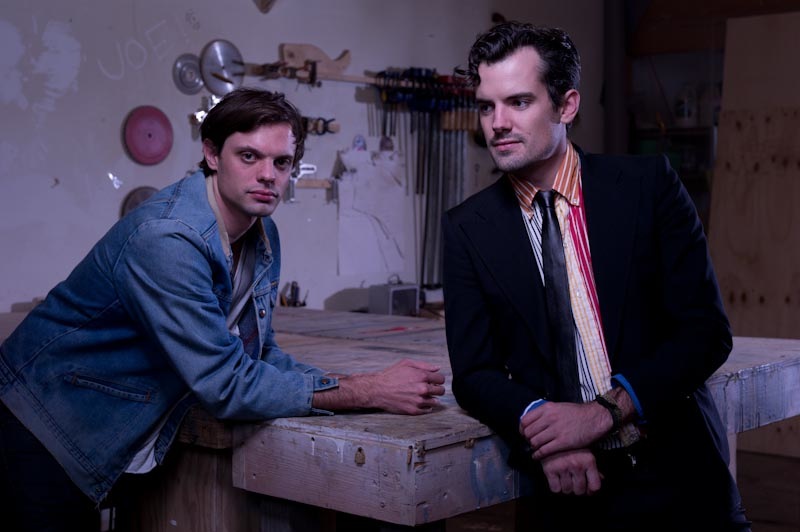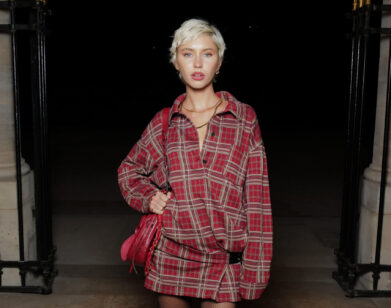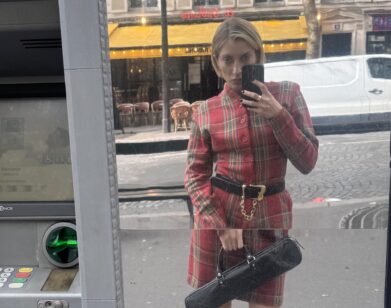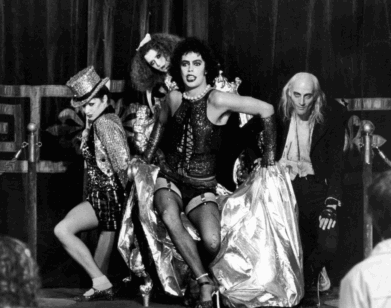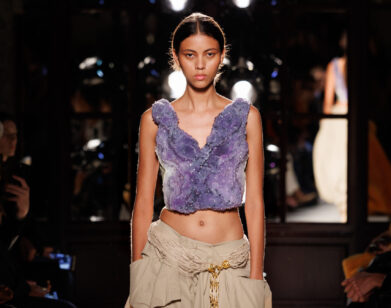The Haas Brothers’ Los Angeles Philosophy
Twin brothers and partners Nikolai and Simon Haas have a philosophy about Los Angeles: Its open-mindedness, its loneliness, its rolling landscape, its warmth, and even its weed blend to make the rising arts capital a catalyst for creative minds. They would know. The past three years have seen them go from blue-collar gigs—Simon, a restaurant cook and Nikolai, a construction manager—to co-heads of their own design studio. They’ve collaborated with Versace and Lady Gaga, and they scandalized last year’s Art Basel with their bestial, sexualized furniture—later to see it become all the rage at Design Miami. They credit it mostly to a couple locals, who recognized and actively supported their talent.
When Roman Alonso, designer of the newly opened L.A. Ace Hotel, and Simon’s early mentor, offered the Haas brothers free rein to decorate the lobby, there was no question what the theme would be. Within weeks, dozens of wispy pencil drawings depicting Hollywood hills, palm trees, and Tinseltown darlings materialized on the white walls. Arnold Schwarzenegger flexes in a corner; Angelyne grins from a billboard. A series of line-drawn cartoon animals run around fire alarms, drink beer near the bar, and rappel down piers. A self-aware chorus, the creatures are meant to relate the city’s innate playfulness.
As it turned out, the mural became a succinct analogy for the brothers’ working dynamic. Simon, who trained as a painter, is responsible for the formally executed images, based on researched photos (most notably one infamous snap of a bald, distressed Britney Spears); the bears are from Nikolai’s imagination. “I could make another one right now,” he mentions, glancing around for pristine wall terrain. While Simon is meticulous, perfecting production processes, Nikolai is more freewheeling—he’s responsible for details like decorative gold feet and testicles affixed to a collection for Design Basel, as well as the leather fetish straps constraining a bench crafted for Versace.
Alonso, who is the creative director of interior design firm Commune, wanted the hotel to feel as though it had been excavated. The brothers’ drawings are based on the idea of a contractor’s unconsidered sketches under walls–so Simon’s studied portraits are as appropriate as the Nikolai’s spontaneous doodles.
Whatever they make, their aim is assuredly not to confuse viewers with high-minded conceptual art. Citing humor and sexuality as guiding principles, they prefer to convey relatable familiarity, rather than erudite ideas. After all, it’s the encouraging spirit of L.A. (which they contrast with New York-style exclusivity) that got the brothers started. Nikolai was working as a construction manager after becoming disillusioned with his music career, when he fortuitously built a few furniture pieces for Tobey Maguire. The movie star was impressed. Nikolai recalls him saying, “You know how many people I’ve had build custom furniture for me and it all sucks? You should be a furniture designer.” He eventually set up the twins with the architecture firm Johnston Marklee, where Simon and Nikolai apprenticed while tackling a project of Maguire’s. The money they made was enough to open their own studio, which they did in September 2010.
Like so many things Hollywood, the Ace’s walls will be an evolving work in progress; the brothers are allowed to revisit the space whenever they want. A waitress tells us they sneak in at night. Shortly before noon, we meet the Haases at L.A. Chapter for coffee.
RACHEL SMALL: I’d love to hear how you got involved with the Ace.
SIMON HAAS: I met Roman Alonso when I was cooking at Elf Café in Los Angeles. He’s the whole reason we did this, at all. He was aware of my paintings and my drawings. He’s been a very supportive, amazing guy. And the Ace is amazing.
RACHEL SMALL: What did you conceive at first?
SIMON HAAS: A friend of [Roman’s] took a wall down, in some 17th-century building, and saw all the contractor’s plans under the plasterwork. It was his inspiration. The whole idea for the hotel was for everything to look like it had been excavated—like everything here is from a long time ago. So he said, “I’d really like you to just go and do it, without a plan.” We wanted to present L.A. so that, as soon as you are here, you have a feeling of what L.A. is like.
NIKOLAI HAAS: We wanted to convey the heaviness of L.A., but how at the same time the history of it makes it humorous and light. L.A. is a place that feels very free. It’s the vibe of having this free, open-minded, awesome city.
RACHEL SMALL: Why is L.A. the theme of the space?
NIKOLAI HAAS: Really big movies get made here. There’s a lot of serious artists. There’s a lot of design history. L.A.’s a place where serious expression happens. But no one can take you seriously at the same time. So it was a perfect project for us. Because we have the same sort of dichotomy. It’s how we work together. It’s a joke, but we take it really seriously at the same time.
RACHEL SMALL: Why do you think that LA has such a draw to designers and architects?
SIMON HAAS: It has an exotic quality that I think artists—and anyone who wants to express himself or herself—is interested in feeling. You can spend a lot of time being relaxed here if you want to. Because everything is so spread out, it’s really easy to shut yourself off it you want to. Even the light here is so beautiful. David Hockney, for example, said he came here because of the light. You can tell his paintings were so affected, and influenced by the quality of the light. It has this alien charm to it that I think is irresistible.
NIKOLAI HAAS: All my artist friends in New York are struggling. We have a 3,500-square-foot facility. My friends are paying the same for 800 square feet. If we had that, there’s no way we could have produced even an eighth of what we’ve produced.
SIMON HAAS: We wouldn’t have ever been able to afford to start our business if we were there, actually.
NIKOLAI HAAS: The last year has been about us getting to do whatever we want to do. Which has been awesome.
RACHEL SMALL: I feel like that’s such a sign that you’ve made it, too. Literally, you have a blank canvas here at the Ace, to do whatever.
SIMON HAAS: Once you realize that it is possible, there’s no reason not to do it.
NIKOLAI HAAS: Roman, that dude is about creating a vibe and a scene. All my friends are like “Can you get me into the Ace party?” And I’m like, “No, it’s private.” Everybody wants to get in. Eight years ago, when we first lived here, everyone was like “Yeah, New York is cooler.” I love New York. But I mean, like, living and working there is impossible. It’s too exclusive. L.A. is more about openness. People don’t really care. But they do pay attention. They’re supporting you–they’re not holding you down.
RACHEL SMALL: What are your thoughts on the art market?
SIMON HAAS: In Basel Miami, I think it was pretty obvious. It’s like you’re on a stock exchange floor, but an art show. I think it’s a shame that a person is buying something only because it is going to appreciate in value. Like, bummer.
NIKOLAI HAAS: There’s an obsession with concept. It started with Duchamp, where it’s this tongue-in-cheek joke. Warhol did the screen prints. It’s incredible work. But, for an idea, the piece cost 10 bucks to make, but it is selling for millions of dollars. Everything we do, it’s really expensive to make. We have a commission now for a dining table that’s going to be over a million, for a table. But making it is going to cost $300,000.
I think that art is moving in a direction where people need to relate to it in a real human way. It’s not about some concept where you have to know what it is you are looking at to appreciate it. I love Cy Twombly, I love Basquiat. I love Warhol, I love Duchamp. All of that stuff is awesome. But it’s not immediately apparent to the Joe Schmo. Artwork is conceptual, but it’s about it being expressive. Expression before concept.
RACHEL SMALL: I was having breakfast in L.A. Chapter. My friend and myself, we were looking at the drawings, and saying “Oh, what’s that, what’s that?” It’s interactive.
SIMON HAAS: We really wanted people to keep discovering stuff as they were walking around. You can talk about it while you’re here.
NIKOLAI HAAS: We weren’t trying to put esoteric characters on the wall. It’s like, Britney Spears, Michael Jackson, Arnold Schwarzenegger. Those people are as fun to admire. There’s no point in trying to make it exclusive. Same thing, it all wraps up into the L.A. lifestyle and attitude.
SIMON HAAS: L.A. has all these celebrity murals everywhere. It’s so L.A. It’s not a new idea, but to get to do it ourselves…
NIKOLAI HAAS: Have you ever played that game, Celebrity? You throw names in a hat, then you charade it out. You end up with names that reflect the people playing. The game is so much fun if people put in names everyone knows. New York attitude–it’s all about who you know. It’s like, “What the hell, can you please just put in James Brown or something so everyone knows who he is?” Then you can dance and be weird and funny. It’s easier to have human connection if you’re not trying to impress somebody. It’s a lot more fun than being like, “I know more than you do.”
SIMON HAAS: We were smoking this weed last night called L.A. Confidential.
NIKOLAI HAAS: And everyone’s like “Wow, this weed is so good, what is it?” And we’re like “That’s a secret; we can’t tell you, I’m sorry.” It’s the best, because you get totally blissed out, but you don’t forget shit, you can still have a conversation. Everyone asks you what it is because it is so good. So you get a lot of opportunities to go “I’m sorry, I can’t tell you.” [both laugh] I’m starting to talk about the difference between L.A. and New York instead of the Ace.
RACHEL SMALL: It’s relevant!
NIKOLAI HAAS: L.A. has a really short history. You don’t have to be burdened by it.
SIMON HAAS: We’ve presented the full history just here, on these walls! I had such a stock of people that I wanted put on here and I couldn’t get to it, just because it takes so much time.
RACHEL SMALL: I feel like you could have done Britney Spears at a so many moments in her career.
SIMON HAAS: I love Britney Spears. I really hope she doesn’t come in here and get sad that I did that [painted her bald]. It’s the only maybe mean-spirited thing that I did in here. But I just love her so much, and I had to.
NIKOLAI HAAS: We fly so much. All I’ll do is watch movies the whole time. You get emotional! When you’re up in high altitude, you get really involved.
SIMON HAAS: Like crying during Saving Private Ryan?
NIKOLAI HAAS: Yeah! I didn’t, but I felt like it. When we were kids, between 18 and 23, we were watching Pasolini, Visconti, The Damned. Now it’s Titanic, Forrest Gump. When I was a kid I was like “That’s all crap because it’s not cool.” But it’s so cool and it’s really good! There are cheesy parts to all of those movies, but there are cheesy parts to everything! Cheese supports the emotion.
SIMON HAAS: If you’re interested in art, or if you go to art school, you can’t really escape the fact that people are going to have more esoteric knowledge. It’s something you need to experience. Once you’ve figured that out, it’s so good to be able to say, “Now I don’t have to do that anymore. Now I can just really enjoy myself.” I think that that’s the key to being able to use all the information that you picked up when you were obsessing over all this esoteric knowledge.
NIKOLAI HAAS: The only point of being a member of the human race is to take to the past and push to the future.
SMALL: How did you start doing design?
NIKOLAI HAAS: Tobey Maguire had the vision to say, “You should be a furniture designer.”
SIMON HAAS: Then we took the money [from our first project] and rented our space. [Nikolai] had to talk me into doing it because I was so comfortable with my relaxed painter life, you know? I did not want to have to work that hard! [laughs] I was sleeping in the shop. It was three years ago. I’m dating the same guy—I had to bring him to my house, which was a shop. My bed was all sawdust-y.
RACHEL SMALL: What do you like most about it?
NIKOLAI HAAS: I like dealing with my twin, who I know better than anybody in the world. We like expressing ourselves. Now we get to do it all the time. With no compromise.
SIMON HAAS: We’ve realized how healthy it is to help each other discover. We’re always developing a shared philosophy. I think that’s what I like most about it—the personal development.
NIKOLAI HAAS: We have 15 employees, and it’s weird because you’re in this sort of father position, oddly enough. Simon’s kind of the bitchy mother, and I’m the nurturing father.
SIMON HAAS: I’m also the fun mom.
NIKOLAI HAAS: I’m definitely stricter, for sure. It’s fun, but it is really trying, because all these people depend on you financially. They look up to you to tell them if they are doing good work. It’s a lot of responsibility, but it helps you grow.
SIMON HAAS: You have to be fair. It is so much harder to manage people than to do anything else we do. But it’s good to have to do it. Everybody that works for us is really awesome.
NIKOLAI HAAS: Not a lot of floaters. They are all dedicated.
SIMON HAAS: We don’t give anyone specific titles. The job is always totally different. We’re not stuck doing the same thing, ever, ever. That’s important for your soul. Being a human is to not be a machine.
RACHEL SMALL: What do you want people to take away from your work?
NIKOLAI HAAS: So many times I’ve been with a friend at an art event. We stand in front of a piece, and they just go “I just don’t get it. Maybe I’m an idiot, but I just don’t get it”—because it is super heady and super conceptual. Concept is important. I’m not saying concept sucks. But I hope people take from our work that it is expressive.
SIMON HAAS: People are very sexual, and they really enjoy humor. You need those things to be happy. Design is so devoid of it a lot of the time. We want people to see the stuff and think, “Oh, that has sexuality,” or “That is hilarious.” We’re making a hammock that is based on testicles. Whether you like it or not, it’s definitely something unusual.
RACHEL SMALL: Well, who doesn’t like a hammock?
SIMON HAAS: Right? Or nuts! Versace let us design this space in which we showed our collection. We made it like an Amsterdam peep show. It was a little bit risqué, it could have looked trashy as hell, but it looked good. We want people to feel the human quality of our pieces.
NIKOLAI HAAS: Sex and humor, intrigue, expression of emotion, all of those really belong in art, more than intellectual prowess [does].
RACHEL SMALL: Bringing it back around, I feel like that’s very Hollywood as well.
NIKOLAI HAAS: For sure. That’s the whole point of art, really. It’s conveying human emotion. Yes, there’s an intellectual aspect to it, but to me it’s totally secondary, and I think it’s taken the forefront. Humans can do a lot with their brains, and it is really interesting. But the more they connect with their emotional self the better they become at being human. And art is a direct translation of that.
THE ACE HOTEL DOWNTOWN LOS ANGELES IS OPEN NOW. FOR MORE INFORMATION, PLEASE VISIT ITS WEBSITE.

